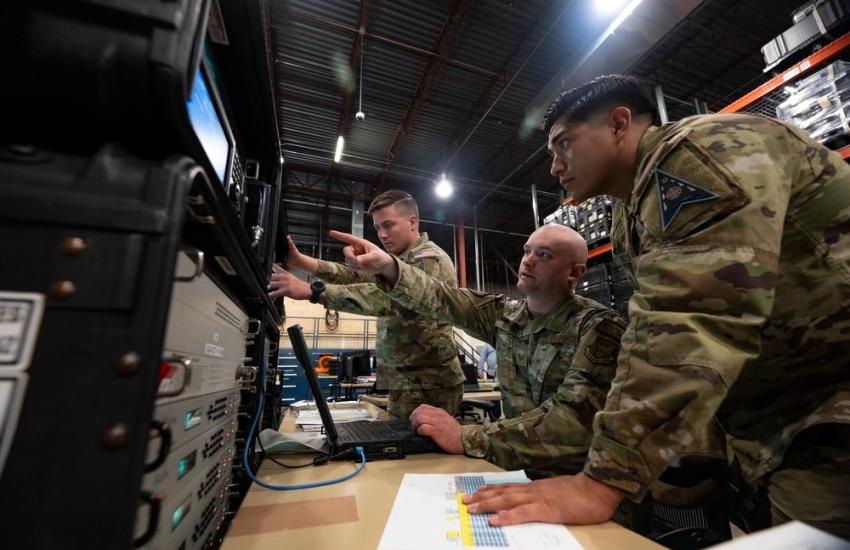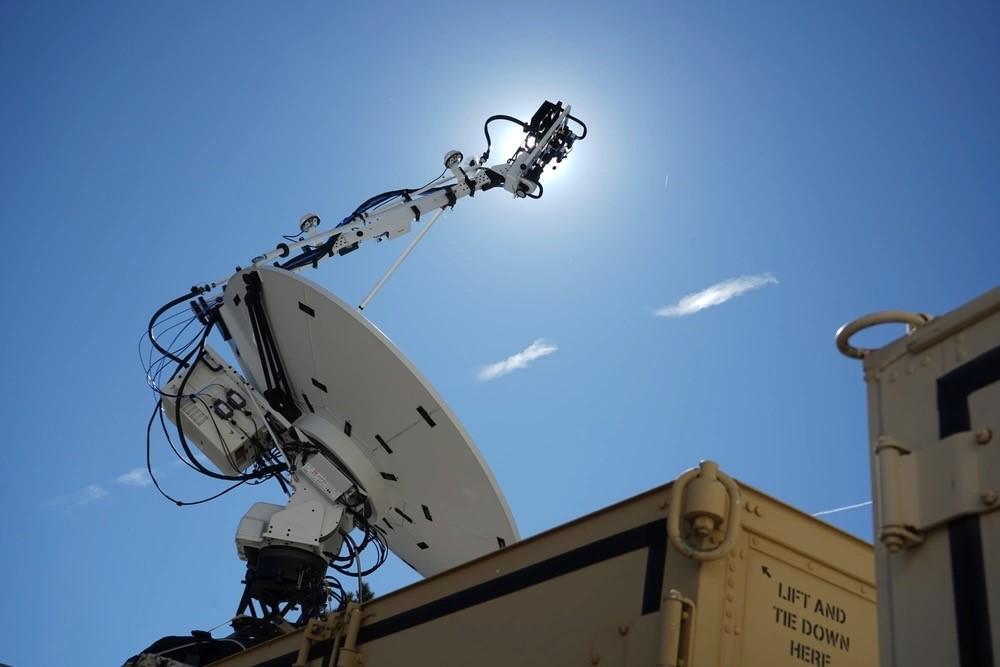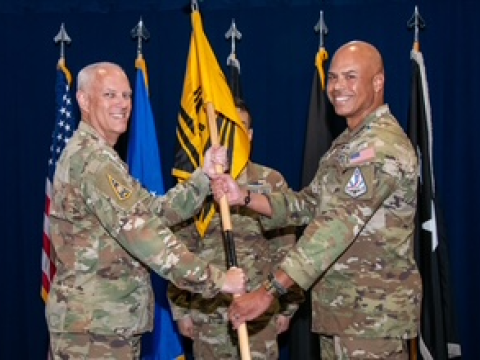OTTI Prepares for Prime Time
To help transform the five-year-old U.S. Space Force into a combat-ready force capable of defending the nation’s crucial space infrastructure against increasingly sophisticated threats, the one-and-a-half-year-old Operational Test and Training Infrastructure (OTTI) office has set an ambitious course.
With the People’s Republic of China—and Russia—mounting increasingly dangerous capabilities designed to harm U.S. space assets, the OTTI is positioning itself to help prepare Guardians with more immersive and seamlessly integrated digital and physical environments. Guardians need to be able to test, train and develop tactics in an operationally relevant platform, with accurate simulation of these complex threats, explained Col. Corey Klopstein, USSF, speaking at AFCEA Los Angeles Space Industry Days in October.
Klopstein is the program executive officer (PEO) for the $4 billion OTTI effort at the Space Systems Command, Los Angeles Air Force Base, California. He stepped into the PEO role in October 2023 when the service stood up the OTTI. The PEO has since pursued the creation of an integrated system-of-systems test and training architecture.
It is a tall order.
The OTTI’s systems include—or will include—live threat ranges; models and trainers, including digital twin features; synthetic test and training environments; and secure facilities and assured networks, according to the organization.
A key shift is moving from testing individual systems to cross-mission area testing and training, focusing on how systems relate to each other and to red threats. Over the next year or two, the OTTI will focus on distributed training, examining how to connect existing capabilities across mission areas.
In the midterm, over the next two to five years, the OTTI’s priority will be developing the digital environment, including building replications of both blue and red assets. The OTTI aims to create a framework for Guardians to test and train 24/7, incorporating specific artificial intelligence (AI)-related elements for threat modeling and reactions.
Starting last fall, Klopstein and other OTTI officials began conducting more industry engagements to gather feedback from the test and training industry on the state of capabilities. The engagements, which will continue into 2025 through organizations such as Space Enterprise Consortium (SpEC), the VA SOS, Space Industry Days, and the Interservice/Industry Training, Simulation and Education Conference (I/ITSEC) 2024 in Orlando, Florida, are helping inform capability requirements, the colonel said.
“Our training previously was focused on the proficiency of operating a system and ensuring that the system would be capable at all times,” Klopstein said, speaking during an I/ITSEC webinar in November. “But as we change from a benign to a contested environment, that has changed what we need from a training standpoint. And as that environment has changed, our standards for readiness have changed, with readiness the CSO’s [Chief of Space Operations Gen. Chance Saltzman] top priority. We have got to have Guardians that can gain and maintain space superiority, and control the domain, not just operate in the domain.”
In the second quarter of 2025, Space Systems Command plans to release a request for proposals for the OTTI’s Integrated Space Test and Training Architecture (ISTAR). They expect to award the contract by the end of 2025, the colonel indicated.
The PEO is also ensuring Guardians are helping to inform the development of the test and training architecture and other live, virtual and constructive systems. Klopstein is leveraging their feedback through tabletop exercises, flag exercises and wargames, with Guardians identifying capability gaps and translating them into requirements.
In addition, the OTTI has a close partnership with the Space Force’s Space Training and Readiness Command (STARCOM). They have created the Integrated Program Office between Space Systems Command and STARCOM personnel to establish a unity of command at the field command level for planning.
So far, the OTTI has stood up a cyber range for space operators, with help from the Air Force’s 318th Cyberspace Operations Group in San Antonio. The cyber range supported about 10 exercises in the first year. “We stood up the Cyber Range in less than four months,” the colonel shared. “Our Cyber Range team went to the 318th and leveraged existing assets and modified them to make them more specific to our space needs so we can train our operators.”
The OTTI also built a transport range operation center, a next-generation electronic warfare range control monitoring capability.
For industry, the colonel emphasized that the OTTI will leverage more than 50 existing contracts with mission partners. “From an execution standpoint, we are looking to leverage any type of acquisition vehicles that are out there to deliver training capabilities, any capabilities that industry can bring to bear that we can integrate into a larger OTTI ecosystem,” Klopstein noted.
In addition to the coming request for proposal later in 2025, the organization will have its so-called Illumination Pathway to further engage and contract with industry. “The second opportunity is what we call on our Illumination Pathway, and we plan to have several different vehicles that we’re going to leverage to ensure that we have full engagement with industry,” Klopstein stated. “We plan to have engagements to the end of 2025 from various vehicles through the VA CSO or SpEC. We will focus on capabilities that are identified in flag or tabletop exercises.”
The OTTI is looking to help Guardians understand how their systems relate to each other and then document the findings from tabletop exercises to translate them into requirements through the U.S. Strategic Command requirements management process. And on a joint level, the training and test environments must illuminate and connect interactions between satellite communications; positioning, navigation and timing; the command and control later; and other systems for fully enabled joint training environments.
And to train to defend against nefarious activity, the OTTI needs to create realistic adversary forces as part of its training environments with simulated red teams against blue teams. This approach represents a significant departure from traditional space operations training.

Moreover, the OTTI wants to evolve from a traditional “Space 100 or Space 200” undergraduate training that dumps Guardians right into operational squadrons. The vision is to change the paradigm with a so-called Space Force Warfare Center and a comprehensive training progression that better prepares operators for the challenges they’ll face in an increasingly contested space domain.
And here again, industry can fill the gaps. “We want to use the feedback that we’re getting from our Guardians to inform what we are going out to industry with and to see what we have. We [must] fill the capability gaps as quickly as possible,” Klopstein clarified.
AI solutions are needed, such as for AI-operated blue systems and red threat systems. Sophisticated modeling and simulation environments are necessary for large-force exercises to train Guardians to create the right effects in a multidomain environment. He also sees digital twins playing several roles, including ensuring an understanding of how digital twins interact with red threats to make sure the OTTI is building a correct representation of its systems.
“Secondly, with as high ability as is possible, using digital twins or models to integrate into the architecture, so that what we are using is the most realistic blue model of an asset in the digital environment,” Klopstein explained.
The integration piece remains one of the OTTI’s biggest challenges. Bringing together diverse systems, physical sensors and simulations into a coherent whole OTTI architecture, including orbital ranges, legacy systems, electromagnetic operations and cyber effects, will not be easy.
“We need your help,” the colonel emphasized. “We need your ideas to make our mission and vision a reality so we can ensure that every system is tested, every tactic is proven and every part is ready.”
Interested industry partners should contact the OTTI through the Space Systems Command’s so-called front door automated platform: SSCFrontDoor@spaceforce.mil.





Comments